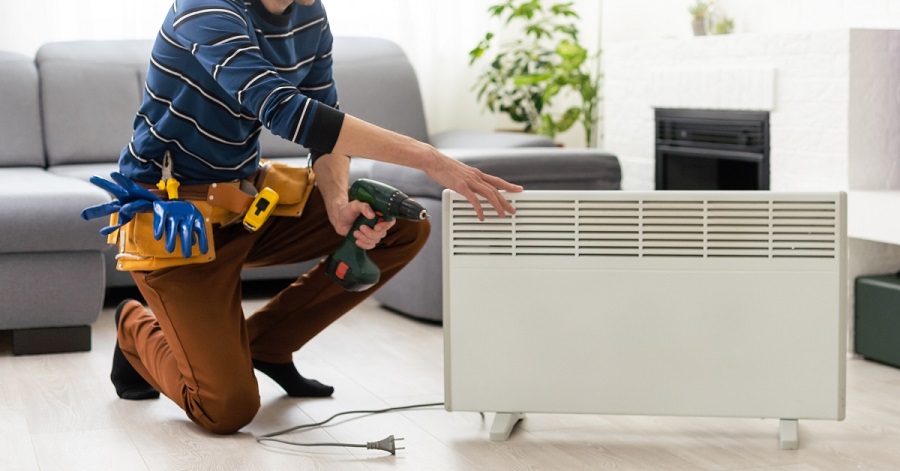As the cold months draw near, preparing your heater for optimal performance becomes increasingly important to ensure a comfortable home for you and your family. Proper residential HVAC maintenance is crucial for improving efficiency, extending the lifespan of your equipment, and preventing unexpected breakdowns during the chillier season.
In this guide, we will provide essential tips and strategies for preparing your heater for winter, ensuring that you stay cozy and worry-free. These steps will help you maximize the full potential of your heating system, allowing you to enjoy a warm sanctuary throughout wintertime.
Perform a Visual Examination
Begin by looking for anything that appears unusual or out of place. Check for any loose or bent vent pipes and ensure that the condensate drain tubes are positioned correctly. If you had furnace maintenance in the fall, everything should still be in good condition. If not, this visual check may reveal that your equipment needs immediate attention.
Inspect and Replace the Filter
When conducting your visual inspection, be sure to remove the air filter from its slot to check if it needs cleaning. A dirty filter can block airflow, so it’s crucial to replace it every one to three months to maintain optimal efficiency and comfort in your home.
Avoid running your equipment without an air filter, as this can harm your heater by allowing debris to settle on delicate components. Additionally, an efficient filter can enhance your indoor air quality by catching dust, pet dander, pollen, mold spores, and other allergens. Regularly replacing the filter is an easy and cost-effective way to ensure your house stays warm and cozy throughout the winter months.
Remove Dirt and Dust
It’s best to leave internal cleaning to a certified HVAC technician, but you can take care of the exterior of your furnace. Start by gently loosening any dirt or dust with a soft-bristled brush. After that, use a vacuum to remove the debris.
Move Flammable Items
It might be tempting to use the space around your furnace for storage, but heating systems require ample room to operate safely. Make sure to keep the area clear of any items within a 10 to 15-foot radius of the unit. It’s crucial to keep flammable materials away from your heater, such as aerosol sprays, cleaning products, and paint cans.
Test the Ignition System and Pilot Light
If you use a gas heater, it’s vital to ensure that the pilot light and ignition system are functioning correctly. Before you turn on your heater for the first time this winter, take a moment to check the pilot light. It should burn a steady blue flame; a yellow or flickering flame may suggest an issue with the gas supply or burner that might need expert assistance.
For heaters equipped with electronic systems, test the ignition to confirm it’s working correctly. If you notice any problems, it’s best to contact a professional technician for a complete inspection.
Check Your Air Vents
Heated air must circulate properly throughout your home to ensure your furnace operates efficiently. Go through each room and inspect the air vents, making sure the louvers are completely open and that no curtains or furniture are blocking them. While you can close some vents to reduce airflow in specific areas, keep at least 80% of your registers open to maintain a balanced system.
Be Cautious of Carbon Monoxide Poisoning
Heating appliances, including combustion furnaces, emit carbon monoxide. When the flue vent operates correctly, this harmful gas should safely escape outdoors.
To safeguard your family from CO poisoning, ensure that the exhaust vent on the outside of your home is clear of obstructions. Additionally, regularly test your carbon monoxide detectors and smoke alarms to guarantee you and your family will be alerted to any CO leaks or fires.
Weatherproof and Insulate Your Home
Any flaw in your house’s exterior can impact the efficiency of your heating system. It’s essential to seal air leaks and enhance insulation wherever you can to achieve a warm and cozy environment. Here are some suggestions:
• Use draft snakes on windowsills and at the base of exterior doors.
• Apply caulk to stationary joints around door frames and windows.
• Install weather stripping to ensure windows and doors close securely.
• Seal any gaps in the attic floor with expanding spray foam.
• Consider putting in an extra layer of insulation in the attic.
• Seal around areas where wiring, plumbing, exhaust vents, and other items penetrate the walls.
• Use foam gaskets in electrical outlets located on exterior walls to reduce drafts.
• Insulate and seal any ductwork that runs through unconditioned spaces like the attic or garage.
Schedule Professional Maintenance
Although you can handle several maintenance tasks for your heater on your own, it’s essential to have a professional HVAC technician examine your system at least once a year. A thorough inspection can uncover potential issues like worn parts or gas leaks before they escalate into significant problems.
Ready To Keep Your Home Cozy and Safe?
For reliable and effective residential HVAC maintenance, contact a reputable HVAC company today. Their experienced technicians can clean and fine-tune your equipment, inspect the gas lines, test the safety features, and ensure the system is running efficiently. Schedule your maintenance appointment before winter to enjoy peace of mind, knowing your heater is prepared to meet the demands of the colder months.

